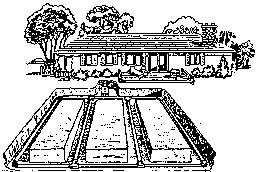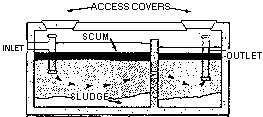|
In rural areas, the septic tank system is the most inexpensive and efficient
method to dispose of household sewage. A septic tank system that is correctly
designed, located, constructed and well maintained will function effectively
and safely for years. An improperly designed, located, constructed or
inadequately maintained system can seriously endanger health and the
environment, and can lead to considerable nuisance and expense.
This Factsheet addresses the care and maintenance of existing septic tank
systems. For the construction, alteration, or enlargement of a private sewage
disposal system a Certificate of Approval for a sewage system is necessary
before any related building construction may begin. In most cases applications
for Certificates of Approval, should be directed to the local health unit which
acts on behalf of the Ministry of Environment.
Fundamentals of a Septic Tank System
A septic tank system consists of a septic tank and a leaching bed. In Ontario
this system is commonly referred to as a Class 4 Sewage System. The septic tank
is typically a two chamber concrete (or other approved material) 3,600 - 4,500
litre airtight tank. The leaching bed is comprised of rows of perforated 3 in
pipe set 1.6 metres apart on a 6 in stone layer. The bottom of the trenches
must be at least 0.5 metres above the groundwater table and 3 ft above bedrock
or impermeable soil.
 |
 |
| Figure 1. Typical Lay-out of Septic Tank Tile Bed System |
Figure 2. Cross-section of the Actual Septic Tank |
The septic tank and leaching bed work together to dispose of household sewage.
Household sewage includes human body waste, toilet or other bathroom waste,
waste from showers and baths, liquid or water-borne kitchen waste or laundry
waste.
As household waste enters the larger first chamber of the septic tank the solid
portion of the waste settles to the bottom of the tank, while fats and grease
rise to the top to form a scum. The settled solid portions are prevented from
entering and plugging the leaching bed. Treatment of the settled solids then
takes place by anaerobic (without air) bacterial action.
The leaching bed receives the relatively clear but highly polluted liquid
portion of the sewage from the septic tank. The sewage is then treated by
aerobic (with air) bacterial action as it filters downward through the soil
from the leaching bed distribution pipes.
Distances from a Septic Tank System
In locating a septic tank system, the following are minimum horizontal distances
that are required under Provincial Regulations. As these distances are
minimums, they may have to be increased to prevent pollution if soil or other
site conditions so dictate or if a raised leaching bed is used.
No septic tank shall be closer than:
-
15 metres (50 ft) to a well, lake, river, stream, watercourse, pond, spring, or
reservoir;
-
1.5 metres (5 ft) to any building or structure (including a swimming pool);
-
3 metres (10 ft) to any property boundary.
No distribution pipe in a leaching bed shall be closer than:
-
15 metres (50 ft) to a well which has a watertight casing to at least 6 metres
(20 ft) below ground;
-
30 metres (100 ft) to a spring used as a source of potable water or a well that
does not have a watertight casing to 6 metres (20 ft) below ground;
-
5 metres (16 ft) to any building or structure;
-
3 metres (10 ft) to any property boundary;
-
15 metres (50 ft) to a lake, river, pond, stream, reservoir or spring not used
as a source of potable water.
Preventative Care and Maintenance
Water Use
Minimize the amount of water used in the household. Excessive use of water could
flush solids from the septic tank to the leaching bed which would lead to
clogging or plugging of the leaching bed pipes.
Each person in Ontario uses about 300 litres (66 gal) of water a day, the
majority of which is used in washrooms by toilets, sinks, showers and baths.
Approximately 45% is used for toilet flushing, 30% for bathing, 20% for dish
washing and laundry, and 5% for cooking.
Water usage in the home should be kept to a minimum to avoid exceeding the
capacity of the septic tank system. If automatic washers and dishwashers are
used, make sure full loads are washed each time and stagger their use to reduce
peak flows. Retrofitting existing toilets to use less water will also ease the
stress on the septic tank and the water supply systems.
Direct all surface waters, pumps, and roof drains away from the leaching bed.
This includes the lawn sprinkler.
Chemical Contamination
Moderate use of household drain solvents, cleaners, disinfectants, etc., should
not interfere with the operation of the septic tank system; however,
indiscriminate use may cause problems.
Do not discharge water softener waste water into the septic tank, unless the
system was designed for the extra capacity. Not only does the extra water
decrease the capacity of your system, the added salts may lead to a failure of
the leaching bed. Water softener waste water should be directed to a leaching
pit.
The use of garbage grinders is discouraged as sludge accumulation in the septic
tank can be increased by up to 40%. The tank will then have to be pumped
annually.
Do not dispose of fuels, grease, paints, thinners, weed or insect killers,
cigarette butts, condoms, paper towels, diapers, sanitary napkins, etc., into
the septic tank system. A septic tank system can only handle bio-degradable
items.
There should be no need to use commercial "starters," "bacterial feeds," or
"cleaners." Bacteria in a septic tank system occurs naturally.
Leaching Bed
The area over a leaching bed should have a good grass cover, but should not be
planted with trees or shrubs. Tree and shrub roots will seek out nutrient-rich
leaching bed tiles and eventually plug them. It is important not to add
excessive amounts of solid (more than 0.3 metres) to the top of the leaching
bed, as this may prevent evapo-transpiration and reduce oxygen transfer to the
bed.
Structures such as patios, pools, sundecks and toolsheds must not be erected
over or near the leaching bed.
Keep all vehicles including snowmobiles off the leaching bed. Any compaction of
the soil reduces leaching bed performance. Crushed leaching bed pipes can cause
backups into your home.
Good ventilation and adequate sunlight should be maintained in the area of the
leaching bed.
Repair Maintenance
The septic tank should be inspected at least once every two years and the tank
pumped out by a licensed contractor every three or four years. Check the local
telephone book yellow pages under "Septic Tanks" for a licensed contractor near
you. Regular pumping of the septic tank is the best preventative maintenance
you can do and well worth the investment.
Warning: Under no circumstances should a home owner enter a septic tank. Noxious
gases which are heavier than air remain in the tank after the top is removed
and have caused death both to the original victim and to those who attempt to
rescue him/her from the tank.
A septic tank will require pumping if the bottom of the floating scum mat is
within 7.6 centimetres (3 in) of the bottom of the outlet fitting or if the
surface of the bottom sludge accumulation is within 46 centimetres (18 in) of
the inlet fitting. Inspection of scum and sludge layers is not a pleasant
task--a septic tank servicing firm can inspect for you.
Septic tank maintenance records should be kept to help you ensure that regular
maintenance is carried out.
Trouble Signs
The following is a list of possible trouble signs that indicate septic tank
system failures:
-
Leaching bed ground is frequently wet and spongy;
-
Extra plant growth over the leaching bed area;
-
Odours coming from leaching bed area;
-
Pooling or bubbling of waste water noticeable on the leaching bed surface;
-
Well water containing nitrates or fecal coliform bacteria,
-
Slow drains in the house.
In the interest of health and the protection of the environment, any malfunction
of a septic tank system must be promptly reported to the local health unit or
Ministry of Environment office.
|































